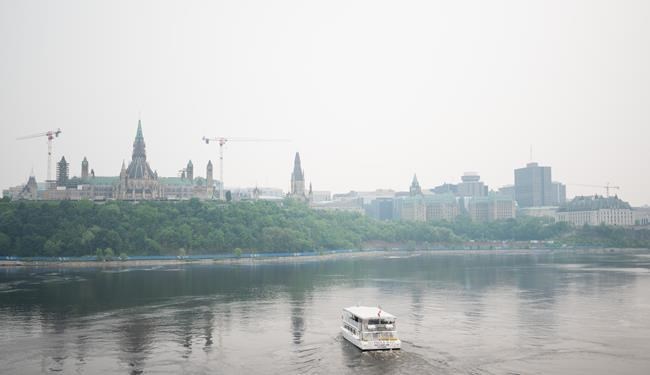Raging wildfires and smoky skies across much of sa���ʴ�ý have put a damper on travel this summer, resulting in cancelled plans and closed businesses.
"We have had a few conversations with our members and we're already seeing domestic and international visitors cancelling trips," said Madison Simmons with the Tourism Industry Association of Ontario.
Simmons pointed to a 2018 study by Visit California, which found that during the state's most destructive wildfire season on record, 11 per cent of potential travellers cancelled their trips to the state, representing a loss of about $20 million that July.
The Ontario tourism group released a study last month suggesting leisure travel in the province was set to grow after being hit by the COVID-19 pandemic and cost-of-living crisis.
Simmons said businesses in the northern part of the province, particularly outfitters and outdoor tours, are most affected.
The wildfires are adding to challenges posed by high gas prices and border delays, she added.
"We're still facing a cost-of-living and cost-of-travel issue. It'll put a further strain on tourism insurance."
sa���ʴ�ý's travel and tourism industry was set to almost fully recover from the pandemic this year, the World Travel and Tourism Council said in mid-May.
But sa���ʴ�ý's emergency preparedness minister warned on Monday that 2023 is now on track to be the worst year on record for fires.
The Canadian Interagency Forest Fire Centre said that as of Thursday, there were 428 fires actively burning across the country, 231 of which were out of control. Some 43,000 square kilometres has burned so far this year.
In Nova Scotia, the number of fires has already about doubled the yearly average. The largest fire in the province's history is currently burning near Barrington Lake, which has forced out thousands from Shelburne County and destroyed 150 structures.
Daniel Khan is vice president of the Shelburne and Area Chamber of Commerce and owns Roseway River Cottages. He said the business is one of many outside the evacuation area that has opened its doors to evacuees.
"We're trying to do our best in terms of managing both the immediate need of people who are local and also our businesses in terms of accommodations with bookings that we have," he said.
Khan said many of bookings until early July are from returning guests who have family in the area while tourists who had planned to explore the province have cancelled. He said it remains to be seen how the fire will affect tourism for the remainder of the summer.
The province recently lifted restrictions on travel and activities in the woods, including hiking and camping, in all areas except for Shelburne County. A provincewide ban on burning remains, including campfires and fireworks.
Quebec, which officials said is experiencing its worst wildfire season, has also prohibited access to forests in several regions. The fires and restrictions have caused many wilderness outfitters to shut down during one of their busiest times of year.
Dominic Dugré, president of industry association Fédération des pourvoiries du Québec, said of the more than 500 outfitters who operate in Quebec's forests, 350 have been forced to close.
Most affected by wildfires in the province are the Abitibi-Témiscamingue and Nord-du-Québec regions.
"We're surrounded by forest so it's our playground," said Nancy Arpin, general manager of Tourisme Val-d’Or.
She noted Val d'Or is near La Vérendrye wildlife reserve and Route 117, the Trans sa���ʴ�ý Highway Northern Route, which is on pre-alert for closure due to smoke.
In northern Saskatchewan, wildfires have forced an Indigenous tourism conference to reschedule.
Candice Evans-Waite is the project coordinator for Westside Indigenous Experience Inc., a non-profit that supports tourism operators in northwest Saskatchewan.
"I feel very shocked and saddened. I don't know what's it's going to be like going back home," Evans-Waite, whose home community is Buffalo Narrows, said of the wildfires. "I think our landscape has drastically changed."
"It's been a huge impact on our industry as well as our communities."
Evans-Waite said around 75 people were expected to attend the symposium in Beauval this week, which would have included a cultural demonstration, lake tours and an artisan market. She said the group also planned to share a tourism strategy it has worked on for six months.
"It was a hard call," she said of the cancellation.
The symposium has been rescheduled for September and Evans-Waite is expecting it to be bigger and better, with a focus on authentic Indigenous experiences.
Keith Henry, chief executive officer of the Indigenous Tourism Association of sa���ʴ�ý, said in 2019 Indigenous tourism contributed nearly $2 billion in revenue to sa���ʴ�ý's economy and supported roughly 40,000 jobs.
"This is a very challenging time for the industry," he said, adding the organization is concerned about environmental impacts. "We were looking forward to a very strong summer this year driven with significant new domestic interest but the wildfires are really having an impact on the consciousness of consumer spending."
Many other outdoor events and businesses across sa���ʴ�ý have been cancelled or are taking precautions due to poor air quality from wildfire smoke.
sa���ʴ�ý's Wonderland said the park is providing KN95 masks to employees who request them as well as additional breaks and advice on steps to take if they or visitors feel unwell. The Toronto Zoo said it is has put precautions in place for animals, including access to the indoors and additional ventilation.
This report by The Canadian Press was first published June 9, 2023.
— With files from Rosa Saba and Sammy Hudes in Toronto and Jacob Serebin in Montreal.
---
This story was produced with the financial assistance of the Meta and Canadian Press News Fellowship.
Emily Blake, The Canadian Press



